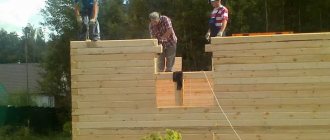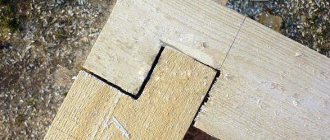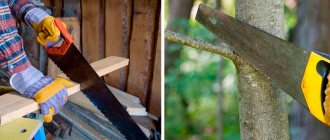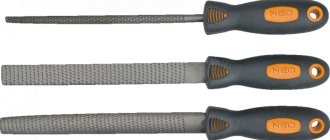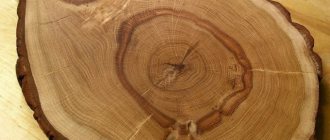Sawing wood with round saws, also called circular saws, is the most common type of wood processing. The simplicity of the equipment, its relatively low cost, combined with high productivity, make it possible to use circular saws in all cutting operations, both in primary and secondary wood processing.
However, despite all the visible advantages, sawing with circular saws has one serious drawback. It lies in the difficulty of ensuring the stability of the circular saw in the cut. As a rule, a circular saw is installed on the saw shaft and fixed. A disk of large diameter but small thickness, having only one support in the center, works with significant loads, including those located outside the plane of the disk.
Due to insufficient rigidity, the disk deviates from the plane of rotation, heats up touching the walls of the cut, which leads to loss of working stability, which means defects and loss of time due to frequent machine stops. The only way to increase the lateral rigidity of a saw is to increase the thickness of the blade, which also leads to a decrease in the useful yield of lumber due to an increase in the amount of sawdust.
General information
Just as there is no panacea for all diseases, there is no one universal saw element for all types of woodworking. For fast, high-quality, and most importantly, safe operation, each operation requires an appropriate disk.
Before choosing a disk, you need to decide on the working material:
- type of wood - hard or soft;
- type of workpiece being processed - boards, plywood, chipboard, the presence of any coating.
cutting will be carried out along or across;
Disks for different tasks
While cross-cutting is best done with a disk with a negative tooth angle, for longitudinal cutting this option is unacceptable due to the occurrence of a repulsion effect, so the model for longitudinal sawing is not suitable for cross-cutting. Negative consequences can occur for the saw engine - sawdust, clogging into the interdental sinuses, creates enormous overloads on the engine.
Note! Bouncing off the surface and, consequently, vibration of the workpiece will not only become an unpleasant sensation for you, but extremely life-threatening. It is especially important to take this point into account when working with an angle grinder, when the chance of getting a terrible injury is especially high.
For each type of work, appropriate disks are selected, which may differ:
- a series or a hint for you in a painful choice;
- the type and angle of the teeth - with a positive inclination, the cut is made faster, but sloppily, with a negative inclination, on the contrary - slowly, but cleanly;
- number of teeth - a large number of them (80−90) are suitable for a clean cut, but the work is slowed down by accumulating chips; the fewer teeth (10–40), the faster the work goes, the chips are removed, but the cut looks torn;
In the photo - a disc for a clean cut
- design - on a high-quality disc, grinding marks diverge from the center, i.e. each was processed separately; the surface should not have roughness, otherwise it will heat up and the teeth will quickly become dull; stiffening rings, wavy expansions and a special coating of the canvas also indicate its good quality;
- outer diameter;
- diameter of the mounting hole;
- maximum speed;
- blade thickness - a thin disk creates minimal load on the engine and can be used in a cordless saw, but it is not suitable for heavy work;
- marking - on high-quality samples it is laser and contains information that is discussed here point by point.
Of course, you should know the technical capabilities of your instrument, which include:
- engine power that will “pull” discs at high speeds; a large number of teeth and their negative angle;
- spindle rotation speed – proportion of blade size = drive power is better not to disturb and not see the consequences;
Rotation speed depending on diameter
- the size of the seating pin, which guarantees a secure fit of the disk; otherwise, an adapter ring is purchased, but it is still advisable to choose the right size. For example, a 200x32 wood saw blade should be mounted on a pin with a diameter of 32 mm;
- permissible outer diameter, the protective casing serves as an additional limiter.
Characteristics and device
The chain saw is presented in the form of a device consisting of a motor that produces torque, and a removable saw part, consisting of a guide bar and a chain with a cutting edge stretched over it. The unit also includes a drive sprocket, a rear handle with a start button and a front handle equipped with a protective shield. The engine can have a longitudinal or transverse arrangement. The transverse placement ensures that the drive sprocket is on the same axis with the engine and significantly simplifies the design. However, with this arrangement the engine is placed to the side, which causes certain inconveniences when working in confined spaces. Models with a longitudinal arrangement do not have this disadvantage, however, they are somewhat more expensive. The principle of operation of the unit is as follows: the engine transmits torque to the drive sprocket, which, in turn, moves a chain closed in a ring along the guide bar.
The main technical characteristics of chain saws are engine power, operating shaft speed and bar length.
- Based on power, devices are divided into 3 categories: low-power, medium-power and high-power. The first ones have a power below 1.5 kW and are intended for trimming branches and sawing thin wooden or plastic blanks. Mid-class models are equipped with a motor with a power of 1.5 to 2 kW. They represent the largest group of devices. They are used in woodworking production, sawing firewood for stoves and fireplaces, as well as in construction and repair. High-end devices are equipped with a motor with a power of over 2 kW, thanks to which they are used in logging work and are capable of sawing logs with a diameter of 30 cm.
- The length of the tire affects the cutting depth and depends on the engine power. Thus, tires 40 cm long are used in combination with a motor with a power of over 2 kW, blades 35 cm long are used with a motor with a power of 1.8 kW, and tires measuring 30 cm are intended for low-power devices.
- The shaft rotation speed has a direct impact on the productivity of the tool: the higher it is, the more workpieces the device can cut in a certain time. However, when choosing a speed, it is necessary to take into account the engine power. A low-power motor will not make a large number of revolutions, all the advantage will come to naught.
More about saw blades
The correct selection and operation of a saw blade affects not only the quality and speed of the cut, but also human safety. So it makes sense to take a closer look at the features of popular models.
Cross and longitudinal sawing
Unlike cutting metal or stone, when working with wood, the direction of the cut is of great importance. This can be explained by the direction of the fibers; because of this, it works completely differently when cutting crosswise and longitudinally.
A 210x30 disc, or any other size for longitudinal sawing, is designed in order to cut the workpiece along the grain as quickly as possible. Among the design features, one can note the increased sinuses compared to other models (this is necessary in order to quickly remove a large amount of sawdust), as well as a smaller number of teeth.
This tooth configuration is optimal for longitudinal sawing
The sharpening angle of the disk is positive, thanks to this the self-grabbing effect is maximized, that is, the saw, as it were, pulls the workpiece towards itself, which makes it easier to feed and increases work safety. If you need to cut a large volume of lumber with your own hands, this will greatly facilitate the work.
Positive sharpening angle
Note! For cross cuts, a large positive sharpening angle is completely unnecessary; it will only create additional problems.
The main difference between cross-cut saw blades is the sharpening angle; it can even be negative if you need maximum control over the feed speed of the workpiece. You can also note a larger number of teeth and a reduced size of the sinuses for removing sawdust.
Longitudinal sawing. Peculiarities
Longitudinal cutting is carried out along the growth of the fibers. During such sawing, much more energy is expended, and the machine heats up much faster than in the case of cross-cutting. However, such costs are fully compensated by the fact that the surface of the lumber when cut longitudinally is smooth. But in the case of a cross cut, the surface can be rough and even chipped.
In fact, rip sawing is similar to splitting blocks with an axe, in which the wedge blade splits the fibers held together by lignin, facilitating further splitting. When ripping wood or chipboard, the cutting surface of the tool breaks the lignin and then cuts the fibers with cutting movements.
Often during longitudinal sawing, internal tension in the lumber is revealed, caused by uneven shrinkage of the fibers, which are compressed or, on the contrary, stretched, pinched by the surrounding fibers and remain in this position until sawing begins.
During the implementation of longitudinal cutting, a significant problem arises. It lies in the fact that the edges of the sawn board can close together. But this problem can be avoided. You should not cut boards that have unevenly distributed annual rings, that is, the appearance of which indicates improper drying. Lumber that has cracks is also not suitable for longitudinal sawing.
Longitudinal sawing of wood should be carried out with a reserve for releasing internal stress. This option makes it possible in the future to get rid of flaws using planing or sawing. Do not forget that the discs used for cutting must be sharp and clean, if possible new.
How to protect yourself when working with a circular saw
Saw blades for wood, if handled incorrectly, can deprive a person of extra fingers or even limbs. Most often, the reason for this lies in violations of the basic rules of working with the device.
The operating instructions include several simple rules:
- It is prohibited to feed short workpieces manually. For this it is better to use special stops;
- It is not advisable to use a saw blade with a grinder. This is the most dangerous option. Even if you hold the tool very firmly, then when a tooth hits a nail or twig, it can jerk so strongly in your hands that you won’t be able to hold it;
It is prohibited to place such a saw blade on an angle grinder.
- some also remove the protective casing, installing a larger disk than the manufacturer intended. This is the right way to the hospital;
- The dimensions of saw blades for wood must correspond to the mounting diameter. If you install a model with a large mounting hole without a special adapter, then eccentricity during rotation can lead to rupture and scattering of the disk. If such a fragment enters the body, the consequences are comparable to a shell fragment.
Precise parallelism setting using hour indicator
This is a more professional and accurate method, but it will require a special device - an ICH-10 hour indicator. In this case, the reference point for the stop is the groove of the disk.
As you can see, this method is much faster and more accurate (division value is 0.1 mm), but such a device costs about 20 USD. e.
Summarizing
Circular saws are an indispensable tool when it is necessary to cut large volumes of lumber. Choosing the right saw blade is no less important than skill in using the tool. The proposed material will allow you to understand the classification and main design features of saw blades for wood. (See also the article Wood sander: features.)
The video in this article is a short overview of the Freud carbide blade.
You may not have thought about it, but the correct choice of a hacksaw determines not only its service life, but also the ease of use and quality of the cut. Let's consider the main parameters of the correct choice of this tool, which is necessary for household and carpentry activities.
First cut
The worst edge must be cut first; the taper of the log is not taken into account. Taking this feature into account means tilting and lifting the log so that the saw works parallel to the bark. From this part will come short boards and a large amount of slab.
Since taper is not taken into account, from the best edge of the log sawing will proceed parallel to the bark without tilting or lifting, this approach will allow you to get a maximum of long boards of good quality.
Drawing of boards of different cuts
Start by cutting the best edge of the log, but take into account the taper. That is, install the log so that the saw is directed parallel to the bark.
The result will be the same, but in the second method it is easier for the sawyer to choose the best edge, since it is visible. In the first method, the best part is hidden and there may be inaccuracies when installing the log. If the wood being cut is of high quality, both methods work equally well. With lower quality raw materials it is better to use the second method.
How to choose a saw?
The wood saw is available in different versions on the market. How products may differ:
- Tooth shape and size;
- Canvas size;
- The grade of steel from which the working part (blade) is made;
- Handle shape.
A hacksaw with a change in one of the specified parameters can radically change its characteristics. Also, sitting comfortably in the hand of one master, it will not suit another at all. These factors must be taken into account when choosing a tool for different purposes.
Teeth size
This parameter affects the quality and speed of work. For convenience in determining the size and number of teeth, the designation TPI was introduced, indicating the number of teeth in one inch . This parameter can be seen in the description of a hand saw for wood; the value is often written on the blade.
- A wood saw with a large tooth produces a rough cut at high speed. It is useful for cleaning the area from branches, cutting boards for firewood and other activities where you can get by with the rough ends of products and trunks. For such instruments, the tooth size TPI 3...6 is selected.
- For products that need to be cut neatly and evenly, a fine-tooth hacksaw with TPI 7...9 is suitable. This type is used for sawing fiberboard, chipboard, laminate, and in repair work. The productivity of such a tool is significantly lower than that of a coarse-toothed one.
A carpenter's saw is selected primarily based on the size of the tooth. So, for ordinary wood, small and large are suitable, but for “delicate” materials such as fiberboard, a fine-toothed saw is needed. In stores you can now find similar designations: “for wood”, “for drywall”, etc. Their main difference is the size of the teeth, which is optimal for sawing each of the materials indicated on the label.
The teeth are distinguished by shape, depending on this the tool acquires different purposes:
- The hacksaw for longitudinal sawing is equipped with triangular teeth with oblique angles. Their appearance resembles hooks that are sharpened on both sides. Because of this, the saw slides along the wood fibers and cuts the blade smoothly, almost without jagged edges.
- The crosscut tool is equipped with teeth in the shape of an isosceles triangle. A mechanical hacksaw of this type cuts as it passes back and forth, but it can only be used for processing dry wood.
- A manual hacksaw for mixed sawing is equipped with both types of teeth alternately located one after the other. Long curved saws the material in the forward direction; in the reverse movement, the triangles expand the channel for passage and catch shavings and sawdust behind them. In modern models, teeth alternate with voids. This allows you to use the saw on dry and freshly cut wood; coarse unnecessary fibers are removed through the holes.
The best brands of chainsaw chains
Based on reviews from the owners of these units, a rating of chains for chainsaws has been compiled. Below are the manufacturers that make the best chainsaw chains.
- Stihl is a very famous Swiss brand that produces saw chains made of high-strength chromium-nickel steel. They do not stretch when heated like regular ones. This is achieved through the use of a special hot riveting method in production. In addition, this manufacturer has patented a lubrication method - “grooves”, which are supplied to all drive links.
- The company does not design chains, but manufactures them using the best patented technologies. Thanks to this, high quality products are achieved. The company also provides a wide range of services to customers, providing warranty service for its products. In addition, the company's clients have the opportunity to purchase original spare parts for mechanisms.
- Oregon is a division of Blount Inc. The company is considered one of the best among companies producing saw elements for chainsaws. Oregon also produces various accessories and spare parts for instruments of other well-known brands. The sawing elements of chainsaws are made of a special patented alloy, and a chromium alloy is applied to the teeth. To facilitate the sharpening process, marks are placed on the teeth indicating at what angle this operation must be performed. In addition, the chains have a system that reduces vibration and an original design, thanks to which the lubricant is distributed evenly.
- Carlton is a company from America. All chain elements from this manufacturer have increased hardness because they undergo shot blasting at the manufacturing stage. The cutting links have a long edge, making it possible to perform a large number of sharpenings.
- Windsor. The company has patented a super-strong alloy that is highly heat-resistant and does not stretch. Windsor saw elements use stamped links and sealed rivets to ensure high reliability.
- The chain is made of alloy steel with chrome-plated teeth. The latter are sharpened in a special way, and a hypoid lubricant is applied to the chain, facilitating the sawing process. The company also uses the shot-peening method in the manufacture of chains, which increases the strength of the links.
One of the most important elements of a chainsaw is the chain, which is the working part of the tool and takes on all the loads. It dulls quite quickly and also wears out. The duration of its operation is affected not only by the frequency of operation of the chainsaw, but also by the quality of the product itself
It is the chain that affects the efficiency of the chainsaw, so special attention should be paid to this element when choosing it
Varieties
By combining the above factors, manufacturers have developed and are now producing standard products with different blades, handle and tooth shapes. To understand how to choose a hacksaw for wood, you first need to familiarize yourself with the existing types of saws.
Type 1: Classic
The main type of saw that almost every man has, even those far from construction and carpentry. This hacksaw can have a blade of any length with a different number of teeth; the tool is often equipped with replaceable blades, which are included with the purchase.
Type 2: Narrow
Its other name is a circular hacksaw. It takes its name from its main application - it cuts out lines of different shapes, and it does it neatly and clearly. It is also used for cutting through round and square holes. The saw blade is narrow, the teeth are frequent, and can be located either on one working plane or on both.
When working with a saw, you should be careful: if you move uncertainly, the blade will turn in the other direction, so when choosing a hacksaw for wood with a narrow blade, you should choose a product made of high-quality hard steel that will not bend during the cutting process.
Type 3: With pad
A hacksaw with a backing is equipped with a stiffening rib (the same backing), which prevents the blade from bending during operation. Thus, the tool is not able to make a cut lower than the width of the working part of the saw.
A backed hacksaw is always equipped with a comfortable handle at an angle of 45° to the blade for easy work execution.
Type 4: Bow
For plumbing, a bow saw is indispensable: it is used for cutting rough parts of the trunk, knots, cutting out figures from plywood and other wood materials, cutting wood along and across the grain. The use of a bow saw is so widespread that it alone can replace a small woodworking machine.
The wide range of work carried out is slightly obscured by the main disadvantages:
- Bulky. A bow saw is a complex structure; its supporting part is made in the form of a large curved arc, to which a narrow, thread-like blade with teeth is attached.
- Fragility. You need to work with the tool extremely carefully: the blade can fly off the mounts and tear during operation; it requires frequent replacement.
Type 5: Reward
The award saw requires a lot of effort to master. This is a tool that resembles a plane. It is equipped with two handles. Its main application is cutting grooves and tenons; the depth of holes and recesses can be of different sizes, and on rocks of any hardness.
Type 6: Folding tool
A mechanical hacksaw that you can take with you on a hike or on vacation. It is compact, lightweight, and completely safe when folded. A folding hacksaw has fine teeth and a short, pointed blade.
(Changed edition, Amendment No. 3).
2 12 The unevenness of thickness within one saw should not exceed, mm
| for saws up to 450 mm diameter | 0,05 |
| for saws with a diameter from 450 to 800 mm | 0,08 |
| for saws with a diameter of over 800 to 1000 mm | 0,10 |
| for saws with a diameter of 1250 mm | 0,15 |
| for saws with a diameter of 1500 mm | 0,20 |
| for saws with a diameter of over 1500 mm | 0,25 |
| (Changed edition, Amendment No. 1,3). | |
| 2 13 The difference between any two pitches of saw teeth should not exceed, mm | |
| for tooth pitches up to 10 mm | 0,4 |
| for tooth pitches from 10 to 20 mm | 0,6 |
| for tooth pitches from 20 to 40 mm | 1,0 |
| for tooth pitches from 40 to 60 mm | 1,5 |
| for tooth pitches over 60 mm | 2,0 |
| 2 14 Tolerance for radial runout of the tips of the saw teeth relative to the axis of the mounting hole | |
| must be, mm | |
| for unsharpened saws | |
| for saws up to 360 mm diameter | 0,5 |
| for saws with a diameter from 360 to 630 mm | 0,8 |
| for saws with a diameter from 630 to 1000 mm | 1,2 |
| for sharpened saws | |
| for saws up to 360 mm diameter | 0,3 |
| for saws with a diameter of 1250 and 1500 mm | 0,8 |
| 2 15 Saw teeth must have the ability to be set or flattened (to the side) at great | |
| rank, mm | |
| for saws up to 1.4 mm thick | 0,6 |
| for saws with a thickness of 1.4 to 2.5 mm | 1,0 |
| for saws with a thickness of 2.5 to 3.6 mm | 1,3 |
| for saws up to 3.6 mm thick | 1,5 |
Selection by purpose
In addition to taking into account the main types of saws, the choice of a hacksaw for wood should be made upon request for a specific type of work:
- Swing for longitudinal sawing;
- Transverse copes well with wood across the grain;
- Tenoning for cutting grooves, tenons and technological recesses in products;
- Circular for cutting holes of different shapes;
- Folding hacksaw for wood
These types of wood hacksaws generalize the above tool models. The choice should be made according to the main purpose for which the selected type of tool is purchased. For the household, it is advisable to purchase a saw with replaceable blades or have several hacksaws of different types in your arsenal .
How to decide
This amount of new information is not easy to put into practice, so we will give you some tips on how to consistently choose the right saw.
- The first factor to consider is what sawn material will be used and what is the desired quality of the cut. Carpenters who work with small wood products choose small saws with a short blade. For a carpenter, it is better to use large teeth and a blade - this master does not require high precision work, speed is a priority. A folding garden hacksaw is ideal for summer residents who will only cut through trees and shrubs.
- Frequency of application. Determine how often you will need to use the tool. If the need arises rarely, take a saw with hardened teeth; if the need for sharpening often arises, use ordinary steel.
- The quality of the steel must be high for a tool with any frequency of use. The higher the class of metal, the better the quality of the product. Before purchasing, take the tool in your hands and carefully bend the blade to 45 0. Good metal is elastic and, when the end of the saw is released, it will restore its shape without displacing the central axis. If you notice a deviation, return the hacksaw to the seller.
- In this case, price is a guarantee of quality. Of course, provided that the seller is honest and does not offer you a fake. A good product cannot be cheap. Choose in the middle price range, if your wallet allows it - don’t skimp on an expensive saw. Select a manufacturer based on its trust rating and give preference to its products in the store. In most cases, this tactic allows you to avoid buying something unknown instead of a good tool.
- Take the hacksaw tool in your hand. You should feel comfortable holding it. The material used can be solid plastic with a rubberized handle.
By following these simple rules, you can easily choose a wood hacksaw that suits your needs.
“>
Types of wood cutting
The quality of the final product depends on a large number of factors - the type of wood and the quality of the raw materials, the professionalism of the workers, and proper drying. However, there is another important aspect - this is the method of cutting timber.
There are the following cutting methods:
- tangential
- radial
- rustic
- longitudinal
- transverse.
Rustic is a cut that is performed at an acute angle to the direction of the grain.
This method is used in the manufacture of lumber for rustic flooring, which can be called the most heterogeneous and original in pattern and shade. During tangential cutting, the cutting plane lies tangentially to the annual layers of the material at a certain distance from the core. Since wood fibers are most often located in different directions, a natural pattern in the form of fancy “arches”, “curls”, “rings” is obtained on the surface. The structure of the board with this cutting option is heterogeneous; wood pores may be present. At the end of the tangential cut, the boards are characterized by an increased coefficient of shrinkage and swelling. Also, this log sawing scheme makes it possible to increase the useful yield coefficient, which causes a reduction in the cost of the final product.
Sawing wood blanks using the radial method is carried out perpendicular to the annual rings. Thus, a homogeneous board is obtained with the smallest gaps between annual layers. This creates an attractive pattern and also increases the strength of the lumber. Radial materials are characterized by high resistance to deformation and wear resistance. Also, such boards have lower rates of shrinkage and swelling compared to tangentially cut lumber. Therefore, finished products, for example, parquet boards, floorboards, block houses, linings, practically do not crack on the front part, but tangentially sawn materials are susceptible to such phenomena. Glued laminated timber is created only from radial and semi-radial cut boards, because the mechanical and geometric parameters are directly dependent on the resistance of the fibers. This resistance increases during gluing of layers with multidirectional annual rings at an inclination angle of no more than 45°.
Only 10-15% of radial boards can be obtained from a single log. Therefore they have a high cost. The best performance is demonstrated by material having an angle between the annual layers and the cutting plane from 80 to 90 degrees.
Cutting methods
For each specific case, a cutting method is selected.
Tumbling is the most economical, almost no waste, high percentage of finished timber. The output is unedged boards and two slabs.
With lumber - first you get a double-edged beam, unedged boards, and two slabs. Then the timber is sawn perpendicular to the cut into edged boards, along the edges two unedged boards and two slabs are obtained.
Methods for cutting wood
Sector - first, the log is sawn into 4–8 sectors, and then each of them into radial or tangential materials. Sometimes several unedged boards are cut in the center.
Break-up-segment - with this type of cutting, two or more unedged boards are cut in the center of the trunk, and edged one-sided boards are sawed from segments on the sides.
Beam-segment - similar to split-segment, only in the middle of the log a two-edged beam is cut, which is then sawn into edged boards. The yield of lumber is high.
Circular - after sawing off one or more unedged boards, the log is rotated 90 degrees and the next boards are sawed off. This method is used when a large log is affected by heart rot in the center. With its help, healthy wood is separated from low-quality wood.
Aggregate - using milling tools and circular saws, along with high-quality lumber, the output is technological chips (instead of slabs and slats). Such complex forest processing allows for rational use of raw materials and labor costs. This results in waste-free production of finished lumber.
